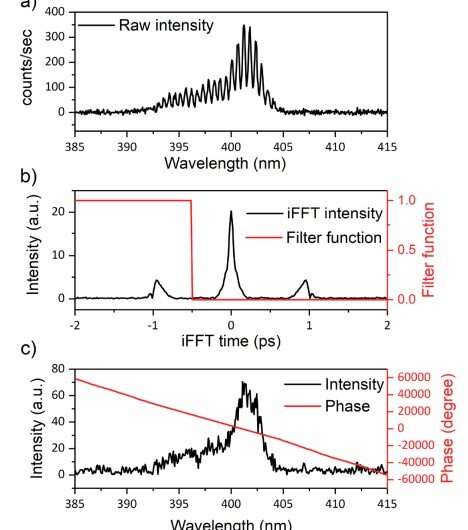This article has been reviewed according to Science X's editorial process and policies. Editors have highlighted the following attributes while ensuring the content's credibility:
fact-checked
peer-reviewed publication
trusted source
proofread
Researchers lift curtain on key feature of interfacial electrochemistry

Materials scientists at Cornell have developed a method for better understanding the complex electrochemical reactions that occur at the interface of water and metal surfaces—an approach that will ultimately lead to better fuel cells and other electrochemical technologies.
Solid-liquid interfaces are key to polarizing a fuel cell so it can transform a fuel's chemical energy into electricity, but a key characteristic that scientists have struggled to measure is the potential of zero charge, the point at which a metal electrode has no excess surface charge.
Using femtosecond lasers that produce a light pulse that lasts less than a trillionth of a second, a research team led by Cornell was able to quantify the potential of zero charge of a platinum-water interface for the first time without the use of invasive probe molecules. The method was published Feb. 13 in the journal Nature Materials, and sheds new light on a poorly understood area of electrochemistry, according to senior author Jin Suntivich, associate professor of materials science and engineering.
"People have theorized that the charge at the interface changes as we change the potential, but how exactly does it change?" Suntivich said. "This study provides the first step to answering this question—where is the potential when the charge is net zero."
The researchers achieved the measuring technique by utilizing electric-field-induced second-harmonic generation, a process based on an optical phenomenon that uses lasers to create a harmonic output signal.
"We first measure the phase of a zero charge platinum surface as a mark," said Pengtao Xu, a tenure-track associate professor of chemistry and chemical engineering at Shanghai Jiao Tong University who led the research as a postdoctoral associate at Cornell. "Then, we scanned the potential of the electrode and monitored its phase, then once we're past this mark, the platinum surface has reached its zero-charge condition."
Using this method, Pengtao and the researchers showed that the potential of zero charge could be changed by introducing foreign nickel atoms into the platinum-water interface, and the change correlated with increased electro-catalytic activity.
"Knowing the potential of zero charge and modifying it with another material could help to design optimal fuel cell electrocatalysts," said Pengtao, who added that the study helped to confirm the hypothesis that the interfacial electric field can affect electrocatalysis in alkaline environments.
The Suntivich research group is using the measuring technique to experiment with other types of materials and expand its applications. Suntivich said, ultimately, the research will contribute toward a greater understanding of how electrostatics enable energy conversion reactions on surfaces.
"The idea of modifying an electric field at a very small scale and using that to do chemistry is an exciting endeavor. Many Cornell researchers have laid the foundation of how electrostatics affect chemistry and materials science," Suntivich said. "This work represents a step toward quantifying electrostatics at an interface and finding where it's neutral—a first marker toward that long-term vision."
More information: Pengtao Xu et al, Optical method for quantifying the potential of zero charge at the platinum–water electrochemical interface, Nature Materials (2023). DOI: 10.1038/s41563-023-01474-8
Journal information: Nature Materials
Provided by Cornell University





















